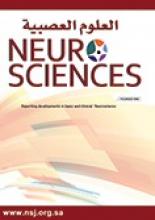Abstract
OBJECTIVE: This study was conducted to ascertain the common bacteria causing brain abscesses in patients admitted to the Neurosurgical Department at Khoula Hospital under the Ministry of Health, Sultanate of Oman. This is the only center that provides neurosurgical services in the Sultanate of Oman. The obtained data were further analyzed to find out what factors predisposed to abscess formation in these patients.
METHODS: A retrospective study of cases of brain abscess from whom samples were received in the microbiology section of the laboratory of Khoula Hospital over the period January 1999 to December 2000 was carried out. The microbiology laboratory records and the patient’s medical records were reviewed to collect the data.
RESULTS: Thirteen patients were identified with a diagnosis of brain abscess. Streptococci were the predominant organism accounting for 53.8% followed by Staphylococcus aureus (26.7%). Other organisms were Bacteroid and Nocardia species. The most common associated condition found was otitis media; others in order being sinusitis and meningitis.
CONCLUSION: Brain abscesses are potentially life-threatening lesions that require immediate intervention. Knowledge of the etiologic agent allows targeted antimicrobial therapy which will be life saving as observed in our series. Our results indicate that the incidence is still high among children and adolescents. Parental/public awareness of the importance of prompt treatment of infections such otitis media, sinusitis, and so forth, can lower the incidence of this disease.
- Copyright: © Neurosciences
Neurosciences is an Open Access journal and articles published are distributed under the terms of the Creative Commons Attribution-NonCommercial License (CC BY-NC). Readers may copy, distribute, and display the work for non-commercial purposes with the proper citation of the original work.






